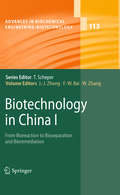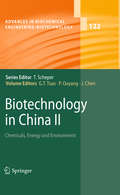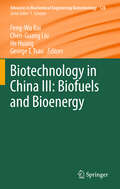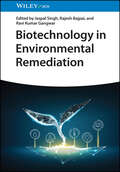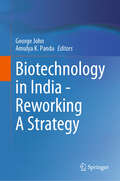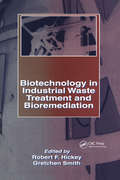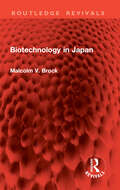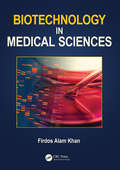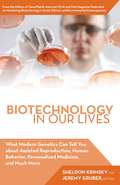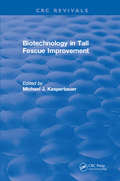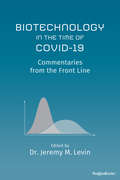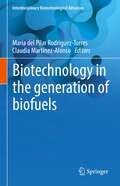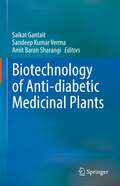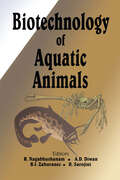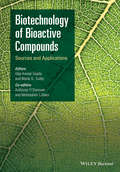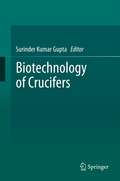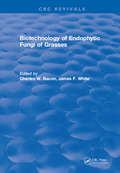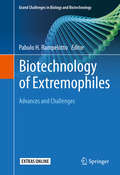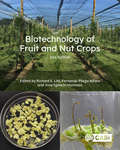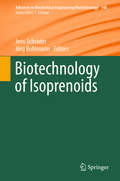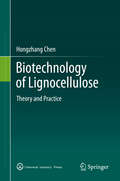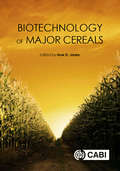- Table View
- List View
Biotechnology in China I: From Bioreaction to Bioseparation and Bioremediation (Advances in Biochemical Engineering/Biotechnology #113)
by Wei Zhang Feng-Wu Bai Jian-Jiang ZhongThis book examines tends in modern biotechnology. It covers all aspects of this interdisciplinary technology, from chemistry to computer science.
Biotechnology in China II: Chemicals, Energy and Environment (Advances in Biochemical Engineering/Biotechnology #122)
by Jian Chen Pingkai Ouyang G. T. TsaoPast, Present, and Future Industrial Biotechnology in China, by Zhenjiang Li, Xiaojun Ji, Suli Kan, Hongqun Qiao, Min Jiang, Dingqiang Lu, Jun Wang, He Huang, Honghua Jia, Pingkai Ouyuang, and Hanjie Ying.- Organic Chemicals from Bioprocesses in China, by Jin Huang, Lei Huang, Jianping Lin, Zhinan Xu, and Peilin Cen.- Biofuels in China, by Tianwei Tan, Jianliang Yu, Jike Lu, and Tao Zhang.- Bioreactors and Bioseparation, by Siliang Zhang, Xuejun Cao, Ju Chu, Jiangchao Qian, and Yingping Zhuang.- Environmental Biotechnology in China, by Shuang Jiang Liu , Lei Liu , Muhammad Tausif Chaudhry , Lei Wang , Ying Guang Chen , Qi Zhou , He Liu , and Jian Chen.- Traditional Chinese Biotechnology, by Yan Xu , Dong Wang , Wen Lai Fan , Xiao Qing Mu, and Jian Chen.- Modern Biotechnology in China, by Qing-Zhao Wang and Xue-Ming Zhao.
Biotechnology in China III: Biofuels And Bioenergy (Advances in Biochemical Engineering/Biotechnology #128)
by He Huang Feng-Wu Bai George T Tsao Chen-Guang LiuCellulolytic Enzyme Production and Enzymatic Hydrolysis for Second-Generation Bioethanol Production, by Mingyu Wang, Zhonghai Li, Xu Fang, Lushan Wang und Yinbo Qu Bioethanol from Lignocellulosic Biomass, by Xin-Qing Zhao, Li-Han Zi, Feng-Wu Bai, Hai-Long Lin, Xiao-Ming Hao, Guo-Jun Yue und Nancy W. Y. Ho Biodiesel From Conventional Feedstocks, by Wei Du und De-Hua Liu Establishing Oleaginous Microalgae Research Models for Consolidated Bioprocessing of Solar Energy, by Dongmei Wang, Yandu Lu, He Huang und Jian Xu Biobutanol, by Hongjun Dong, Wenwen Tao, Zongjie Dai, Liejian Yang, Fuyu Gong, Yanping Zhang und Yin Li Branched-Chain Higher Alcohols, by Bao-Wei Wang, Ai-Qin Shi, Ran Tu, Xue-Li Zhang, Qin-Hong Wang und Feng-Wu Bai Advances in Biogas Technology, by Ai-Jie Wang, Wen-Wei Li und Han-Qing Yu Biohydrogen Production from Anaerobic Fermentation, by Ai-Jie Wang, Guang-Li Cao und Wen-Zong Liu Microbial Fuel Cells in Power Generation and Extended Applications, by Wen-Wei Li and Guo-Ping Sheng Fuels and Chemicals from Hemicellulose Sugars, by Xiao-Jun Ji, He Huang, Zhi-Kui Nie, Liang Qu, Qing Xu and George T. Tsao
Biotechnology in Environmental Remediation
by Rajesh Bajpai Jaspal Singh Ravi Kumar GangwarA timely overview of techniques for involving biological organisms in the remediation of polluted ecosystems As a result of worldwide industry, urbanization, and population growth, many harmful organic and inorganic pollutants have been introduced into the environment. With bioremediation, we can use fungi, bacteria, and plants—along with their secondary metabolites—to clean up areas that have been affected by industrial and commercial activities. Biotechnology in Environmental Remediation presents a thorough consideration of the most important biologically-based remediation methods in use today. Environmental biotechnology is a more sustainable alternative to chemical and mechanical remediation methods, which explains the rapidly growing popularity of these techniques. This edited volume summarizes our current understanding of bioremediation approaches and presents research outcomes from a diverse selection of geographies and ecosystems. Chapters cover remediation techniques for pollutants affecting soil, water, air, and sediments, as well as tools for addressing these issues, including tools for assessment and monitoring. Uniquely, Biotechnology in Environmental Remediation emphasizes the latest findings on the use of secondary metabolites in bioremediation. Other topics covered include chemical sustainability, nanotechnology, and biofuels. Readers will gain an understanding of issues including: How biological organisms and their secondary metabolites are currently being used in environmental remediation projects worldwide New applications for phytomolecules, lichens, nanoparticles, rhizobacteria, and other technologies, as well as future directions for bioremediation The steps in the process of biotechnology-driven remediation, including detection, investigation, assessment, cleanup, redevelopment, and monitoring Remediation of petroleum hydrocarbons, algal carbon sequestration, wastewater management, and the role of fatty acid and proteins in remediationThe investigations in this book provide important knowledge for researchers in biotechnology, ecology, environmental science, and related disciplines. Additionally, policymakers and NGOs with an interest in remediating environmental contaminants will gain valuable context. Biotechnology in Environmental Remediation is a foundation for future research on biotechnological interventions for a clean planet.
Biotechnology in India - Reworking A Strategy
by Amulya K. Panda George JohnThis book examines the progress in the biotechnology sector in India towards knowledge and innovation driven Bioeconomy. The chapters of the book review different genome editing techniques and the GM crops focusing on the emerging potential in agricultural biotechnology. Chapters on Vaccines and AI in healthcare unfold huge opportunities in medical biotechnology. The book covers the advances in biotechnology towards delivering important benefits of healthcare, particularly through the pharmaceutical industry focusing on new healthcare interventions and delivering innovations. Further, it explores the major opportunities in industrial biotechnology related to bio-pharma, biorefinery, fermentation biotechnology, and growing synergies between industry-academia. Toward the end, the book also reviews the genetic regulation and the critical role of HRD. In summary, the book emphasizes on India as a strong bio-manufacturing hub for innovative, affordable and accessible products for the society and also for global markets while describing the sector wise strategies required.
Biotechnology in Industrial Waste Treatment and Bioremediation
by Gretchen Smith Robert F. HickeyBiotechnology in Industrial Waste Treatment and Bioremediation addresses the increasingly important topic of waste treatment. Focusing on microbiological degradation of contaminants, it offers a representative picture of the current status of environmental biotechnology and lays a solid foundation of the methods and applications of bioremediation. The expert presentations of case studies in this new book demonstrate successful treatment schemes and technologies meeting regulatory standards. These case studies represent an international cross-section of strategies for developing and implementing the evolving technologies of bioremediation. Biotechnology in Industrial Waste Treatment and Bioremediation examines the primary waste streams, including air, water, soils, and sediments, and explores specific treatment methodologies for industrial and environmental contaminants. This broad and unique coverage allows treatment firms and regulatory authorities to determine and develop appropriate treatment strategies for site-specific problems of waste remediation. The observations and successful field applications compiled in Biotechnology in Industrial Waste Treatment and Bioremediation make it an excellent reference for understanding, evaluating, developing, and operating efficient and cost-effective full-scale treatment systems.
Biotechnology in Japan (Routledge Revivals)
by Malcolm V. BrockIn the early 1980s, biotechnology caused worldwide excitement as a high technology with almost unlimited potential in science, medicine, and industry. It not only allowed the manufacture of traditional products more quickly and inexpensively, but also offered the possibility of synthesizing valuable materials anew. All this made it very attractive to Japanese policymakers, who ‘targeted’ it as a high priority area for economic growth.Originally published in 1989, Biotechnology in Japan is the first published in English to analyse the Japanese effort to promote the new biotechnology industries. The author examines the strategies used for developing biotechnology in Japan and looks at the active role of government in a field in which the Japanese rapidly became the world leaders. Focusing on the making and implementation of biotechnology policy, he considers the relationship between the public and the private sector, and makes use of different political constructs to analyse Japan’s complex and unique balance between competitive market forces and collective interest.
Biotechnology in Medical Sciences
by Firdos Alam KhanAs the field of medical biotechnology grows with new products and discoveries, so does the need for a holistic view of biotechnology in medicine. Biotechnology in Medical Sciences fulfills that need by delivering a detailed overview of medical biotechnology as it relates to human diseases and epidemiology, bacteriology and antibiotics, virology and
Biotechnology in Our Lives: What Modern Genetics Can Tell You about Assisted Reproduction, Human Behavior, and Personalized Medicine, and Much More
by Sheldon Krimsky Jeremy GruberFor a quarter of a century, the Council for Responsible Genetics has provided a unique historical lens into the modern history, science, ethics, and politics of genetic technologies. Since 1983 the Council has had leading scientists, activists, science writers, and public health advocates researching and reporting on a broad spectrum of issues, including genetically engineered foods, biological weapons, genetic privacy and discrimination, reproductive technologies, and human cloning.Biotechnology in Our Lives examines how these issues affect us daily whether we realize it or not. Written for the nonscientist, it looks at the many applications of genetics on the world around us by posing questions such as:What should we know about genetics and childbirth?Can our genes keep us from qualifying for health insurance?Can gene therapy cure cancer?Is behavior genetically determined?Why would the FBI want our genes?Are foreign genes in our food?And much moreUltimately, this definitive book on the subject also encourages us to think about the social, environmental, and moral ramifications of where this technology is taking us.
Biotechnology in Space (SpringerBriefs in Space Life Sciences)
by Günter Ruyters Christian Betzel Daniela GrimmThis book summarizes the early successes, drawbacks and accomplishments in cell biology and cell biotechnology achieved by the latest projects performed on the International Space Station ISS. It also depicts outcomes of experiments in tissue engineering, cancer research and drug design and reveals the chances that research in Space offers for medical application on Earth. This SpringerBriefs volume provides an overview on the latest international activities in Space and gives an outlook on the potential of biotechnological research in Space in future. This volume is written for students and researchers in Biomedicine, Biotechnology and Pharmacology and may specifically be of interest to scientists with focus on protein sciences, crystallization, tissue engineering, drug design and cancer research.
Biotechnology in Tall Fescue Improvement
by Michael J. KasperbauerThis one-of-a-kind publication focuses on the improvement of the feed value of tall fescue and further extension of its adaptability under various environmental stresses. This fascinating work comprehensively explains cell and tissue culture methods which are used to establish somatic cell cultures, select among cells, and regenerate plants with the genetic characteristics of the selected cells. This up-to-date volume includes information on cultural haploid plants from immature pollen grains. It also evaluates the plants under various environmental stresses to identify genotypes with superior characteristics. This book also features research data on somatic tissue culture methods and doubled haploids. Biotechnology in Tall Fescue Improvement is an indispensable resource and useful text for all those involved with agronomy, plant physiology, horticultural science, crop science, and botany.
Biotechnology in the Time of COVID-19: Commentaries from the Front Line
by Dr Jeremy M. Levin47 leaders from across the biotechnology industry tell their stories of battling the global scourge of COVID-19. Pandemics have killed at least a half billion people over the past two millennia. But in the age of biotechnology, humanity is no longer defenseless. The biotechnology industry is a diverse community of scientists, doctors, patients, entrepreneurs, investors, bankers, analysts and reporters, all committed to treating and curing disease. Over the past forty years, it has produced medical advances at an electrifying rate. As the COVID-19 pandemic emerged, hundreds of companies quickly pivoted to combating the virus. The contributors to this book offer inside views of this seminal industry, with historical and personal perspectives, lessons learned, and looks into the future. Diverse as these leaders are, they are united by their conviction that science and medicine will light humanity&’s way to greater health and longevity.
Biotechnology in the generation of biofuels (Interdisciplinary Biotechnological Advances)
by Maria del Pilar Rodriguez-Torres Claudia Martinez-AlonsoThis book approaches biofuels from a new biotechnological perspective with the aim of equipping researchers with a thorough, up-to-date understanding of biofuel research and related technologies. Topics include biomethane, bioethanol, biobutanol, biomass, hydrolysis, bio-oil, microbiology, and many more. Biofuel research has evolved mechanisms to advance their utilization and their application in our system. The chapters will provide concise and up-to-date information to aid our understanding of biotechnology-related implications of biofuels development and its advancements. Readers in the areas of bioengineering, sustainability, renewable energies and biotechnology will find this work useful to widen their knowledge and perspectives on biofuels.
Biotechnology of Anti-diabetic Medicinal Plants
by Amit Baran Sharangi Saikat Gantait Sandeep Kumar VermaThis book is a unique overview of insights on the genetic basis of anti-diabetic activity, chemistry, physiology, biotechnology, mode-of-action, as well as cellular mechanisms of anti-diabetic secondary metabolites from medicinal plants. The World Health Organization estimated that 80% of the populations of developing countries rely on traditional medicines, mostly plant drugs, for their primary health care needs. There is an increasing demand for medicinal plants having anti-diabetic potential in both developing and developed countries. The expanding trade in medicinal plants has serious implications on the survival of several plant species, with many under threat to become extinct. This book describes various approaches to conserve these genetic resources. It discusses the whole spectrum of biotechnological tools from micro-propagation for large-scale multiplication, cell-culture techniques to the biosynthesis and enhancement of pharmaceutical compounds in the plants. It also discusses the genetic transformation as well as short- to long-term conservation of plant genetic resources via synthetic seed production and cryopreservation, respectively. The book is enriched with expert contributions from across the globe. This reference book is useful for researchers in the pharmaceutical and biotechnological industries, medicinal chemists, biochemists, botanists, molecular biologists, academicians, students as well as diabetic patients, traditional medicine practitioners, scientists in medicinal and aromatic plants, Ayurveda, Siddha, Unani and other traditional medical practitioners.
Biotechnology of Aquatic Animals
by R. Nagabhushanam A. D. Diwan B. J. Zahuranec R. SarojiniThe book aims to present the current developments in select areas of biotechnology of aquatic animals, covering relevant information from the different fields. The book is a comprehensive set of reviews of our existing knowl-edge in biotechnology of aquatic animals. It is written principally as a comprehen-sive reference for students and teachers,
Biotechnology of Bioactive Compounds: Sources and Applications
by Maria G. Tuohy Vijai Kumar Gupta Anthonia O'Donovan Mohtashim LohaniBioactive compounds play a central role in high-value product development in the chemical industry. Bioactive compounds have been identified from diverse sources and their therapeutic benefits, nutritional value and protective effects in human and animal healthcare have underpinned their application as pharmaceuticals and functional food ingredients. The orderly study of biologically active products and the exploration of potential biological activities of these secondary metabolites, including their clinical applications, standardization, quality control, mode of action and potential biomolecular interactions, has emerged as one of the most exciting developments in modern natural medicine. Biotechnology of Bioactive Compounds describes the current stage of knowledge on the production of bioactive compounds from microbial, algal and vegetable sources. In addition, the molecular approach for screening bioactive compounds is also discussed, as well as examples of applications of these compounds on human health. The first half of the book comprises information on diverse sources of bioactive compounds, ranging from microorganisms and algae to plants and dietary foods. The second half of the book reviews synthetic approaches, as well as selected bioactivities and biotechnological and biomedical potential. The bioactive compounds profiled include compounds such as C-phycocyanins, glycosides, phytosterols and natural steroids. An overview of the usage of bioactive compounds as antioxidants and anti-inflammatory agents, anti-allergic compounds and in stem cell research is also presented, along with an overview of the medicinal applications of plant-derived compounds. Biotechnology of Bioactive Compounds will be an informative text for undergraduate and graduate students of bio-medicinal chemistry who are keen to explore the potential of bioactive natural products. It also provides useful information for scientists working in various research fields where natural products have a primary role.
Biotechnology of Crucifers
by Surinder Kumar GuptaDespite the recent advances made in the improvement of crucifer crops using conventional breeding techniques, the yield levels and the oil and meal quality could not be improved as expected. The understanding of genetic material (DNA/RNA) and its manipulation by scientists has provided the opportunity to improve crucifers by increasing its diversity beyond conventional genetic limitations. The application of the biotechnological techniques will have major impacts in two ways: first, it provides a number of techniques/methods for efficient selection for favorable variants and second, it gives an opportunity to utilize alien variation available in the crucifers by using the novel techniques of biotechnology to develop high yielding varieties with good nutritional quality, having resistance to insect, pest, and disease resistance.
Biotechnology of Endophytic Fungi of Grasses
by Charles W. BaconThis book considered the biological, ecological, toxicology, and chemical aspects of research topics as they relate to endophytes of grasses. Several chapters reflect the very pragmatic applications of endophytes and endophyte-infected grasses. Other chapters offer future applications for endophytes and are therefore discussed from theoretical viewpoints. This book contains the collective writings of an international group of experts on fungal endophytes of grasses, all of whom are directed toward, understanding, creating, and exploiting the positive aspects of endophytes. With this book, we are attempting to stimulate and facilitate future explorations of the grass endophytes.
Biotechnology of Extremophiles: Advances and Challenges (Grand Challenges in Biology and Biotechnology #1)
by Pabulo H. RampelottoAimed at research scientists and biotechnologists, this book is an essential reading for those working with extremophiles and their potential biotechnological application. Here, we provide a comprehensive and reliable source of information on the recent advances and challenges in different aspects of the theme. Written in an accessible language, the book is also a recommended as reference text for anyone interested in this thriving field of research. Over the last decades, the study of extremophiles has provided ground breaking discoveries that challenge our understanding of biochemistry and molecular biology. In the applied side, extremophiles and their enzymes have spawned a multibillion dollar biotechnology industry, with applications spanning biomedical, pharmaceutical, industrial, environmental, and agricultural sectors. Taq DNA polymerase (which was isolated from Thermus aquaticus from a geothermal spring in Yellowstone National Park) is the most well-known example of the potential biotechnological application of extremophiles and their biomolecules. Indeed, the application of extremophiles and their biologically active compounds has opened a new era in biotechnology. However, despite the latest advances, we are just in the beginning of exploring the biotechnological potentials of extremophiles.
Biotechnology of Fruit and Nut Crops
by Maria Luisa Badenes Patrick Brown Nicolas Roux Araceli Barceló-Muñoz Vicente Vicente Óscar Martínez Eddo Rugini Luciana Baldoni Alain Rival Magda-Viola Hanke Henryk Flachowsky Julie Graham Luis A. Cañas Dennis J. Gray Stephen Adkins J. R. Botella Leandro Pena Ossama Kodad Pedro Martínez-Gómez Abhaya Dandekar Sadanand A. Dhekney Yuval Cohen Kate Evans Nuria Alburquerque Pedro M. Barros A. T. Basford Muhammad Ajmal Bashir Diego Silva Batista Dr Julianne Biddle Manuel Blasco Lorenzo Burgos John E. Carlson Elisabeth Carmona David Chagné Rekha Chaudhury Elisabeth Chevreau V. E. Chhatre Yelda Özden Çiftçi C. Claflin Elena Corredoira Valerio Cristofori Niccolò Cultrera Maurecilne Lemes da Silva Leo D’Souza Ofere Francis Emeriewen M. Faize Fábio Gelape Faleiro Ana Paula Farinha Yolanda Ferradás Antonio Figueira Maureen M.M. Fitch M. Foale Svetlana Y. Folimonova María Victoria González Isabel María González-Padilla Smitha Hegde Professor Jose Ignacio Hormaza Uma Jaiswal Nikki Jennings Hülya Akdemir Koç Nerea Larrañaga Chuck Leslie Z. J. Li Amanda De Lopes Carlos López-Encina Rodolfo López-Gómez Jorge Lora Zheng-Rong Luo S. K. Malik Roberto Mariotti Antonio J. Matas José Mercado Scott Merkle Sara Montanari Gloria Moore Soraya Mousavi Isabel Narváez María Del Naval Q. T. Nguyen Shashikiran Nivas M. Margarida Oliveira Ahmet Onay Guillermo Padilla Elena Palomo-Ríos Andreas Peil Rosa M. Pérez-Clemente Cesar Petri Paula M. Pijut Marcos Vinícius Pinheiro Clara Pliego Fernando Pliego-Alfaro Simon H.T. Raharjo Manoj K Rai Manuel Rey Gabino Ríos Diego Ismael Rocha M. B. Rosenberg M. Rouard D. Ruiz J. Sardos Danielle Camargo Scotton Cristian Silvestri Michael K Smith Guo-Qing Song Veysel Süzerer Alicia Talavera Ryutaro Tao Takuya Tetsumura Engin Tilkat Pablo Ric Varas Wagner Vendrame Francisco Javier Viéitez Hazel Wetzstein Roxana Yockteng Qing-Lin ZhangThis book covers the biotechnology of all the major perennial fruit and nut species. Since the publication of the first edition of this book in 2005, there has been significant progress in cell culture, genomics and genetic transformation for many of these species. This book covers these biotechnologies and also traditional ones, such as regeneration pathways, protoplast culture, in vitro mutagenesis, and ploidy manipulation that have been applied to many of these species. Three species, Diospyros kaki (persimmon), Punica granatum (pomegranate) and Eriobotrya japonica (loquat) are included for the first time, and several Prunus species now receive separate coverage. The species are organized by plant family to facilitate comparisons among related ones. Each species is discussed in relation to its family and its related wild forms, and most are accompanied by full colour illustrations. This book is a vital resource for those working on the improvement of perennial fruit, nut and plantation crops. The book features: Detailed coverage of major perennial fruit and crop species. Coverage of traditional and new biotechnologies. Full colour illustrations to aid identification This book is an essential resource for scientists and postgraduate students who are engaged in the improvement of perennial fruit, nut and plantation crops and will also be an important accession for university and agricultural research libraries.
Biotechnology of Hairy Root Systems (Advances in Biochemical Engineering/Biotechnology #1192)
by Pauline M. DoranVictor P. Bulgakov, Yuri N. Shkryl, Galina N. Veremeichik, Tatiana Y. Gorpenchenko and Yuliya V. Vereshchagina: Recent Advances in the Understanding of Agrobacterium rhizogenes-Derived Genes and Their Effects on Stress Resistance and Plant Metabolism. Le Zhao, Guy W. Sander and Jacqueline V. Shanks: Perspectives of the Metabolic Engineering of Terpenoid Indole Alkaloids in Catharanthus roseus Hairy Roots. Jian Wen Wang and Jian Yong Wu: Effective Elicitors and Process Strategies for Enhancement of Secondary Metabolite Production in Hairy Root Cultures. Amanda R. Stiles and Chun-Zhao Liu: Hairy Root Culture: Bioreactor Design and Process Intensification. Marina Skarjinskaia, Karen Ruby, Adriana Araujo, Karina Taylor, Vengadesan Gopalasamy-Raju, Konstantin Musiychuk, Jessica A. Chichester, Gene A. Palmer, Patricia de la Rosa, Vadim Mett, Natalia Ugulava,Stephen J. Streatfield and Vidadi Yusibov: Hairy Roots as a Vaccine Productionand Delivery System. Zahwa Al-Shalabi and Pauline M. Doran: Metal Uptake and Nanoparticle Synthesis in Hairy Root Cultures.
Biotechnology of Isoprenoids (Advances in Biochemical Engineering/Biotechnology #149)
by Jens Schrader Jörg BohlmannThis book review series presents current trends in modern biotechnology. The aim is to cover all aspects of this interdisciplinary technology where knowledge, methods and expertise are required from chemistry, biochemistry, microbiology, genetics, chemical engineering and computer science. Volumes are organized topically and provide a comprehensive discussion of developments in the respective field over the past 3-5 years. The series also discusses new discoveries and applications. Special volumes are dedicated to selected topics which focus on new biotechnological products and new processes for their synthesis and purification. In general, special volumes are edited by well-known guest editors. The series editor and publisher will however always be pleased to receive suggestions and supplementary information. Manuscripts are accepted in English.
Biotechnology of Lignocellulose: Theory and Practice
by Hongzhang ChenThis book presents and summarizes the new thoughts, new methods and new achievements that have emerged in the biotechnology of lignocellulose in recent years. It proposes new concepts including the primary refining, fractionation, multi-level utilization and selective structural separation of lignocellulose, etc. By approaching lignocellulose as a multi-level resource, biotechnology could have a significant effect on ecological agriculture, bio-energy, the chemical and paper making industries, etc. , ultimately establishing distinctive eco-industrial parks for lignocellulose. Additionally, this book provides systematic research methods for the biotechnology of lignocellulose including investigation methods for the primary refining of lignocellulose, for microbial degradation and enzymatic hydrolysis, for cellulose fermentation and for lignocellulose conversion processes. It offers an excellent reference work and guide for scientists engaging in research on lignocellulose. Dr. Hongzhang Chen is a Professor at the Institute of Process Engineering of the Chinese Academy of Sciences, Beijing, China.
Biotechnology of Major Cereals
by Li Zhu Wendy Wendy Ning Zhou Jeffrey Beringer James Bing Chen Wei Tristan Coram Tanya Curtis Jim Jim Sylvester Elikana Anami Gabor Gabor Nigel Nigel Hai-Chun Jing Balázs Kalapos Cuma Karaoglu Anca Macovei Hilde-Gunn Hilde-Gunn Kaitlin Pidgeon Ayten Salantur Parwez Samnakay Inez Slamet-Loedin Alexandra Soltész Caroline Sparks Nicholas Storer Yong-Wei Sun Kerry Swartwood Attila Vágújfalvi Joyce Joyce Gen-Ping Wang Huixia Wu Lan-Qin Xia Xiu-Dao Yu Li-Xin Zhang Yu-Miao ZhangBiotechnology of Major Cereals focuses on the recent advances and future prospects in cereal biotechnology. The first part of the book covers the world's major cereals and focus on new developments and trends. The second part is technology rather than species-led, detailing fundamental developments in technologies and significant target traits.
Biotechnology of Major Cereals
by Huw D. JonesBiotechnology of Major Cereals will focus on the recent advances and future prospects in cereal biotechnology. The first part of the book will cover the world's major cereals and focus on new developments and trends. The second part will be technology rather than species-led, detailing fundamental developments in technologies and significant target traits.
